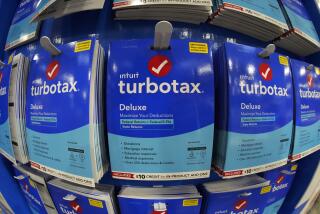A Wise Investment to Save on Taxes
- Share via
Income tax preparation programs have been around for more than a decade but, until a couple of years ago, they were usually more trouble than they were worth. It didn’t seem worth spending time and money on a program when, for less effort, you could do your taxes manually or take them to a professional tax preparer.
I no longer feel that way. Tax-preparation suppliers have improved their programs and lowered their prices, making this software an excellent choice for many taxpayers. I’m impressed by Andrew Tobias’ TaxCut (DOS, Windows and Macintosh) from Meca and TurboTax (DOS and Windows) and MacInTax from ChipSoft. These programs are widely available for less than $50.
Last year, slightly more than 2 million tax-preparation programs were sold nationwide, up 40% from 1991, according to Link Resources, a New York research firm. Dan Caine, a Boston-area tax lawyer who created Meca’s TaxCut, expects that number to grow considerably in 1993, based on early sales. TaxCut, he says, has enjoyed more than 30% annual growth during the last three years.
ChipSoft, publisher of TurboTax, claims that its software was used to prepare more than 7 million returns. That number includes returns prepared by tax specialists, who used a professional version of TurboTax.
“Our biggest challenge,” said Caine, “is to write software that is fast and simple for the person with the simple return, yet deep and thorough for those with complex returns.”
Both TaxCut and TurboTax are reasonably robust, surprisingly easy to use and may remind you of working with a tax professional. Both programs use an interview approach to elicit information needed to complete IRS forms. You answer the questions; the program figures out where to put the information.
Both programs make extensive use of “branching technology.” For example, if you tell the software that you’re single, it won’t ask you questions about your spouse. Once it knows you’re filing jointly, it will ask you the appropriate questions.
The programs handle a long list of forms and schedules--more than enough for most taxpayers. Nevertheless, there is no way they can include every possible IRS form.
Tax-preparation software isn’t for everyone. If you have a very simple return, you’re better off completing a 1040EZ form manually. If your tax situation is more complicated, and you need strategic advice, an accountant or tax lawyer is probably a better choice. Some people who use tax software still consult with a tax professional to be sure they’re taking advantage of every possible deduction.
Neither TaxCut nor TurboTax can take the place of a good tax adviser. For example, neither program can help you determine the best strategy for your retirement funds or how to handle a tax-deferred savings or investment plan.
The IRS is a strong supporter of tax-preparation software. “The real benefit to us is that it lets us take advantage of the software’s ability to prevent users from entering mistakes,” said Robert Carver, deputy commissioner of returns processing. Manually prepared tax returns have an error rate of about 17%, according to Carver. Returns completed by computer “have reduced the taxpayer error rate to 2%.”
This year, the IRS has authorized broader use of the 1040PC. Instead of printing regular tax returns, TurboTax, TaxCut and MacInTax can print forms that are, essentially, data input sheets for the IRS. The 1040PC doesn’t look very pretty, but it uses less paper, is cheaper to mail and costs the government a lot less to store.
As of now, the IRS is manually entering the data but plans are underway to install optical character-recognition equipment that can automatically scan the form. That should result in far fewer operator errors and faster refunds.
It’s already possible for software users to file their returns electronically. That does cut down on the IRS’s processing time and typically results in a faster refund. Unfortunately, taxpayers can’t yet dial up the IRS on their own. You have to go through a service bureau and pay a $20 fee. This will change over time. Although it hasn’t formulated any specific plans, the IRS, according to Carver, is exploring ways to allow taxpayers to electronically file on their own or via an on-line service such as CompuServe, Prodigy or America Online.
More to Read
Inside the business of entertainment
The Wide Shot brings you news, analysis and insights on everything from streaming wars to production — and what it all means for the future.
You may occasionally receive promotional content from the Los Angeles Times.










